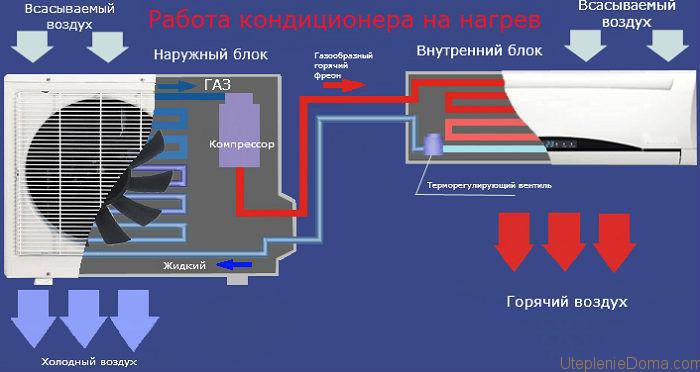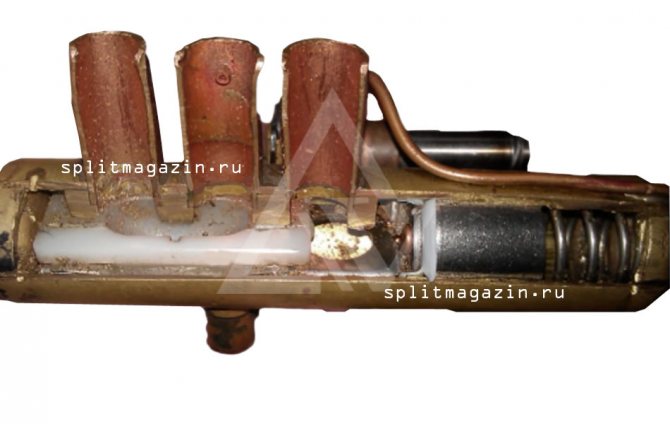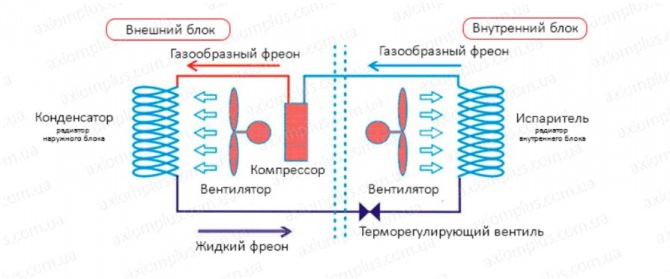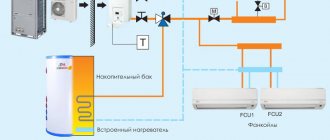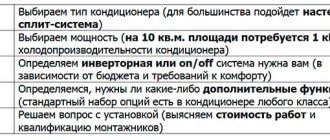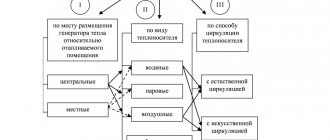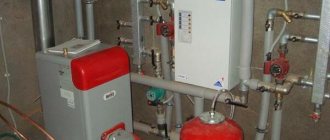HVAC equipment is an actively developing area of production. The need to install such equipment has become an integral element not only in the design and construction of office buildings or shopping centers - more and more often you can find projects of residential buildings in which a design solution for the installation of an air conditioning system is provided. Modern stationary air conditioners are also called split systems, due to their design feature - they consist of two parts: the indoor unit is in the room inside, and the outdoor unit is outside. Moreover, some models of split systems can not only cool the air in the room, but also heat it, that is, they work in winter-summer mode. How the air conditioner is heated, in which models this option is provided, and what parameters affect the choice - in the material below.
The validity of heating a room with an air conditioner
Often buyers have a question - what is the best way to heat the room, air conditioning or gas. To understand how profitable it will be to use an air conditioning system for this purpose, and to find the most economical heating method, it is necessary to compare several factors:
- device cost;
- operating conditions and restrictions - low outdoor air temperatures significantly limit the use of air conditioners;
- savings in relation to other heat sources.
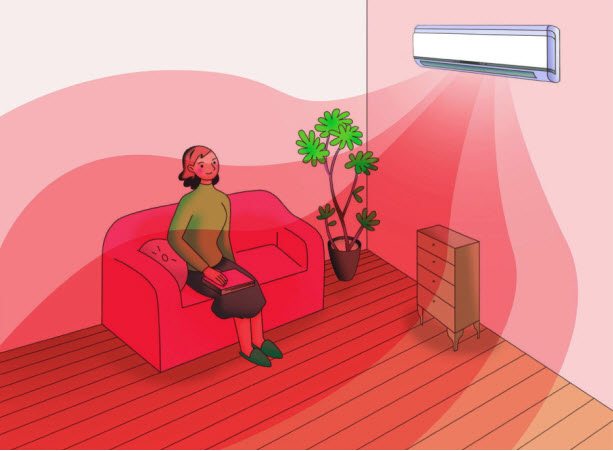
Analysis of the data shows that it will be beneficial to use an air conditioner as a heating device for a country house if no gas is supplied to the dwelling, and you have to choose between diesel fuel, coal, liquefied gas or electricity as a heat source.... Also, heating a room with an air conditioning system can be considered by owners of houses without a stove.
It should be noted that it is more profitable to use split systems for heating in regions with mild winters, since models that can operate at low temperatures are more expensive and require special maintenance. If frosty weather prevails, or the network gas is supplied to the house, then heating the home through the air conditioning system will have few advantages.
On a note! Heating with air conditioning is advisable, for example, in the off-season, when it is already cool outside, but the utilities have not yet turned on the central heating.
The principle of operation of the air conditioner in heating mode
All split systems for heating in winter have the same operating principle. The unit pumps heat into the room according to the principle of operation of a heat pump. In the device, the process of condensation of liquid takes place, which transfers heat from one medium to another.
Freon condenses under high pressure in the heat exchanger of the indoor unit, which heats up to 80 ° C. After that, the already liquid freon goes into the outdoor unit, where it boils and evaporates. Thanks to this principle, it is possible to use the air conditioner for space heating.
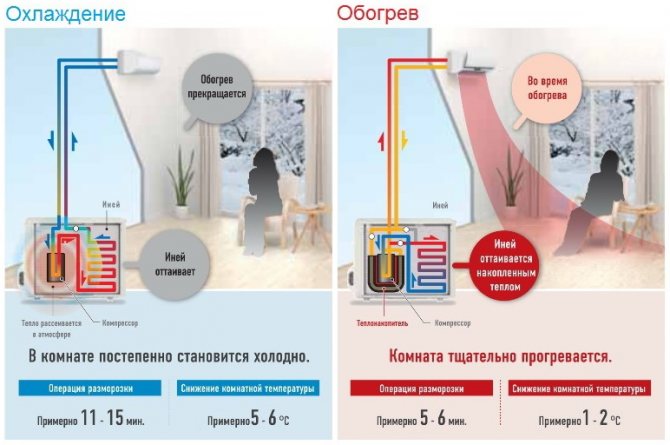

The principle of operation for heating
The main operating principle of the air conditioner, whether it be heating or cooling, remains unchanged and is based on a change in the state of aggregation of the refrigerant, which, like all substances, absorbs heat during evaporation and releases it during condensation. The used refrigerant circulates between the indoor and outdoor units and transports the heat either outdoors or indoors.
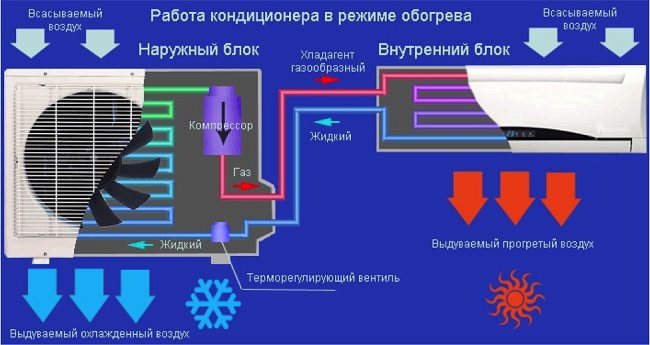

Freon is used as a refrigerant, which can equally easily be heated and cooled due to evaporation, condensation, expansion and contraction. Therefore, a decrease in temperature is achieved as a result of the conversion of freon into a gaseous state, and an increase, on the contrary, into a liquid form. The compressor is responsible for the compression of freon, and its expansion occurs in the capillary tube. Changing modes from cooling to heating becomes possible by changing the movement of freon, which is achieved by installing a 4-way valve that changes the direction of flow.
When the air conditioner turns on heating mode, the following occurs:
- in the external unit, the compressor compresses freon, which heats up from this and then flows through the tubes to the internal unit.
- being in the inner part, the heated refrigerant gives off heat to the air in the room through a heat exchanger and cools down;
- the freon that has given off the heat enters the street unit again and, evaporating, gives off the residual cold to the street air through the heat exchanger - this happens even if there is frost outside the window;
- then the process is repeated: freon enters the compressor, where it is compressed and heated.
How to turn on the air conditioner for heating without a remote control
Many models of split systems have an active control panel on the indoor unit. It can be touch-sensitive or ordinary, in the form of buttons. Sometimes it is hidden under a plastic cover.
If the buttons or control sensor are not visible, you need to open the front cover of the air conditioner. To do this, find grooves or protrusions under your fingers in its lower part on the right and left and pull it towards you and up (see photo).
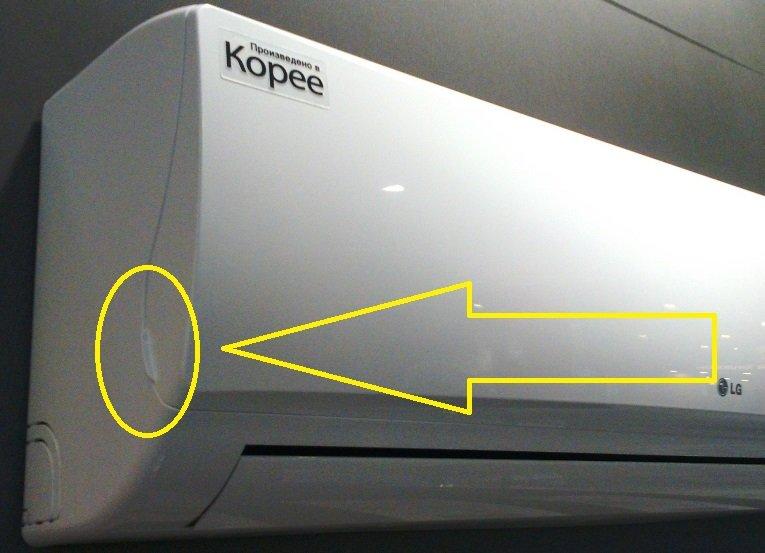

Once the control panel is visible, it may not have an ON / OFF button. To turn on the air conditioner without a remote control, you need to use a hidden button. It is located on the panel to the right of the air filter. It can be marked as "ON / OFF" or "AUTO".
To turn it on, you need a regular pen. Depending on the diameter of the hole, reach for the button with either the stylus or the back. To turn off the air conditioner, follow the same procedure.
Temperature limits
There is an important limitation for all air conditioners: the minimum temperature at which it can operate. This is due to the fact that for the normal functioning of the compressor, oil is needed, which begins to thicken at low temperatures, which is fraught with damage to the device at startup.
Important! At low temperatures outside, freon may not have time to evaporate, then it will enter the indoor unit in liquid form, and this can provoke a water hammer.
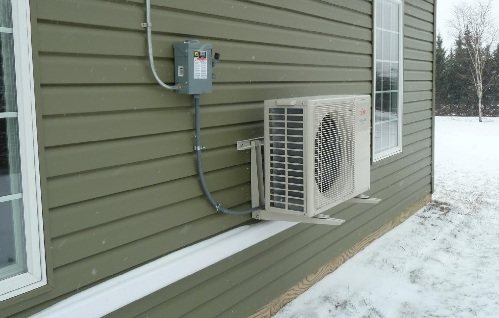

The minimum temperature that allows the air conditioner to function normally is -80C for most models. Some split systems have a lower allowable value: up to -150C. However, even in these models, the performance of devices at sub-zero temperatures deteriorates by 70% of the data indicated in the technical data sheet.
On a note! To compensate for negative weather factors, many experts recommend using a special winter kit, which consists of an oil heater for the compressor and radiators that are resistant to condensation and icing.
Features of work
All air conditioners work according to the same principle: when moisture evaporates heat absorbed, with condensation - produced... More modern models have an air heating function. A specific valve changes the refrigerant flow.
The technique works at room temperature, not lower than -5 ° C... Otherwise, the power is significantly reduced. At low temperatures, internal parts can freeze up. However, some split systems are capable of withstanding the cold. The power can be adjusted to ensure good functionality.Temperature limits are indicated in the instructions. It is not recommended to turn on the device at the maximum threshold, since all thermometers have a small error.
In the air conditioner no heating elementsas in standard heating devices. To switch, no need to change accessories. The mode is changed on the remote control. After a certain period of time (it is indicated in the instructions), the air warms up to the required temperature.
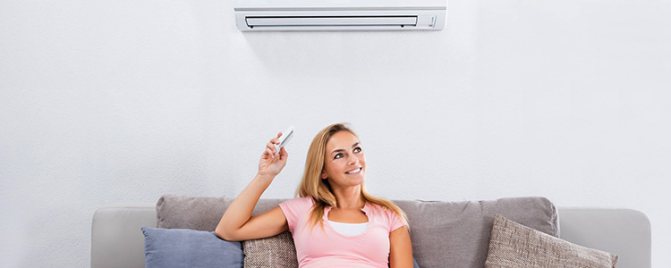

Varieties of air conditioners for heating
Since the main weaknesses of split systems operating on heating are the loss of performance and an increased risk of breakdown at low temperatures, manufacturers are constantly working on improving the design of devices, as well as developing new types of refrigerants. There are several types of these air conditioners, each with their own pros and cons.
Split systems with heat pumps
Split systems with a heat pump are complex engineering designs designed to increase the efficiency of heating the room even when operating in frosty conditions. Such a device is distinguished by the following design features:
- increased size of the heat exchanger;
- installation of a more efficient fan in the outdoor unit, which improves the efficiency of heat transfer;
- heating the compressor crankcase, as well as the outdoor unit, which, when operating at low temperatures, prevents the formation of ice;
- more precise regulation of the refrigerant supply to the heat exchanger depending on weather conditions, which is carried out using an electronic control valve.
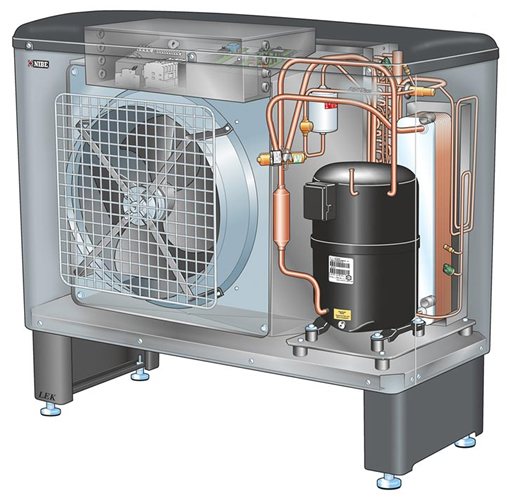

On a note! Many models of equipment with a heat pump use special types of freon that are effective at low temperatures.
Air source heat pump with boiler
This is one of the types of split systems that are designed for heating or cooling, as well as for supplying hot water. In addition, an air source heat pump with a boiler can become part of the underfloor heating system. Unlike most models operating on the air-to-air principle, this type of device uses the air-water principle in operation.... Such a device is perfect for a private house located in an ecologically clean area, since it does not emit combustion products into the air.
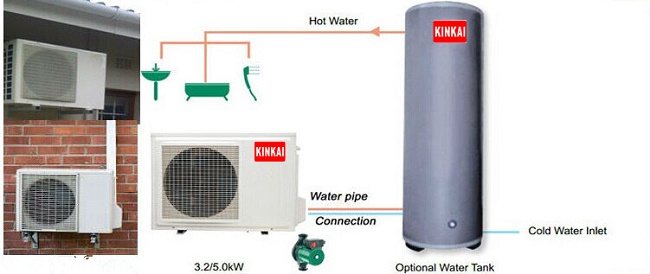

Constant performance systems
For large premises, for example, shopping or office centers, not separate air conditioners are used, but semi-industrial systems of constant performance. They are complex engineering structures of several types.
- Cassette split systems are not built into the wall, but into the suspended ceiling and, thanks to their design, distribute the air flow in 4 directions simultaneously. This ensures uniform heating of a large pavilion.

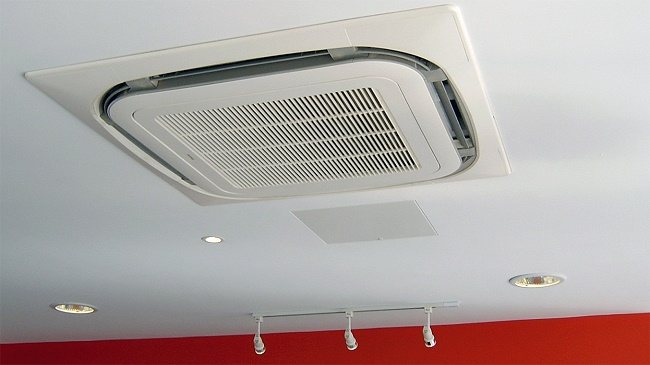
- Floor-to-ceiling air conditioners help to create an optimal microclimate in rooms where it is difficult to place wall-mounted or cassette devices, since they can be installed on the floor close to the wall or on the ceiling of the building. The fastening is secured by a special mounting plate.

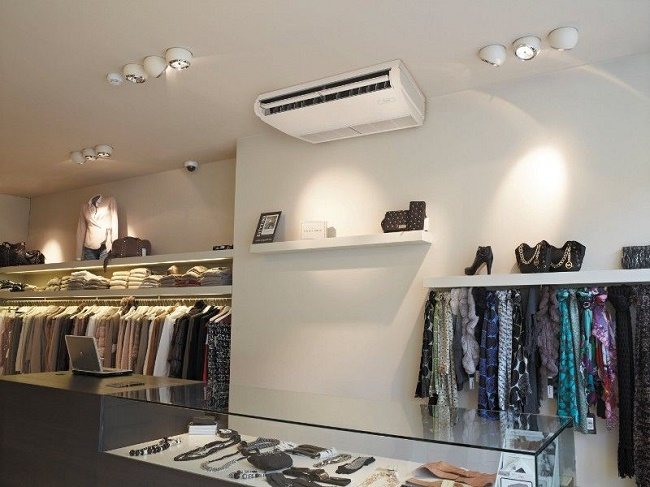
- Duct models are another type of semi-industrial systems, the peculiarity of which is that the external unit is not mounted on the wall of the building, but mounted inside the air duct system. For this reason, duct systems are preferred when the street unit must be hidden from prying eyes.

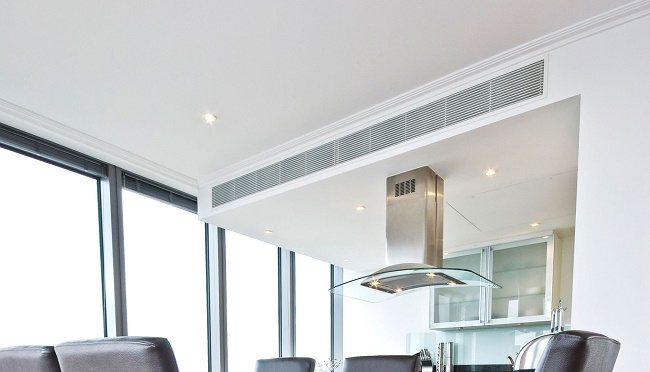
- Column air conditioners are installed on the floor in offices, cafes and other establishments where architectural features or design exclude the possibility of installing climate control equipment on the ceiling or wall. The device itself is made in the form of a column, does not take up much space and directs the air flow to the ceiling.

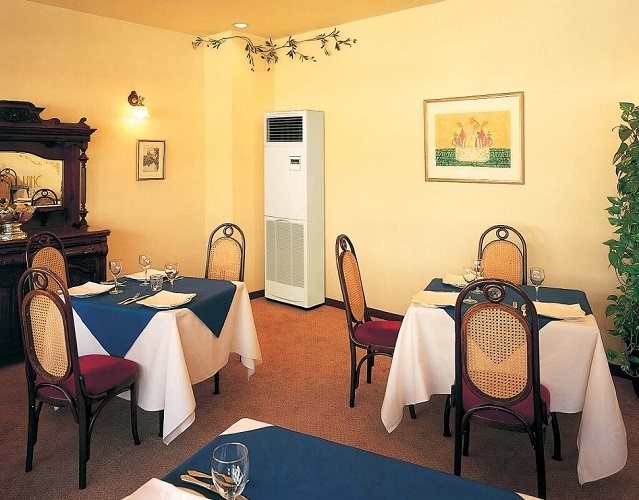
Inverter systems
Conventional air conditioners with heating mode, when the room reaches the required temperature, turn off the compressor and put it into standby mode until the values decrease. This leads to quite large temperature fluctuations. In addition, constant switching on and off of the device increases the wear of its parts.
Inverter models are distinguished by the ability to regulate the speed of the compressor motor, therefore maintaining the set value is achieved by changing the performance of the device. This leads to small fluctuations in the room temperature and saves electricity as much less electricity is consumed at low engine speeds.... Therefore, many buyers prefer inverter models.
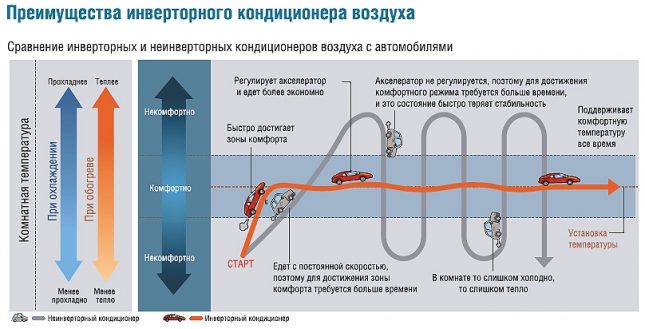

Arctic execution
Split systems of arctic performance are called devices that have been specially designed to operate at low temperatures. For example, there are models that cope with the task of heating even at -300C.
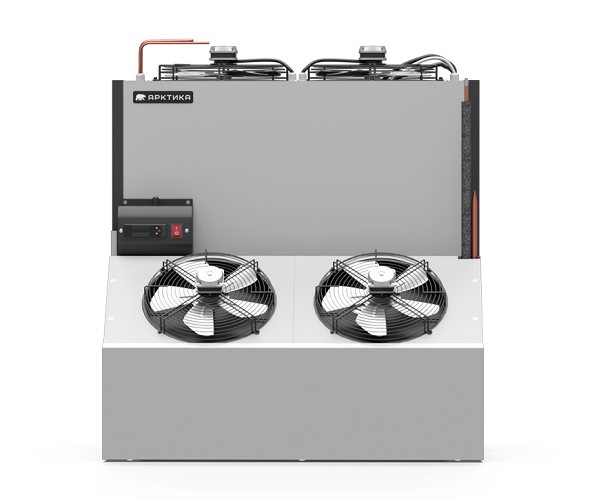

Monoblocks
To simplify the design and installation of complex air conditioning systems, as well as to minimize the use of freon lines, it is often practiced to install compact heat pumps for local heating.
On a note! Such devices are quite cheap. The only requirement is that the outside of the air conditioner is outdoors. Therefore, monoblocks are built into a wall or window.
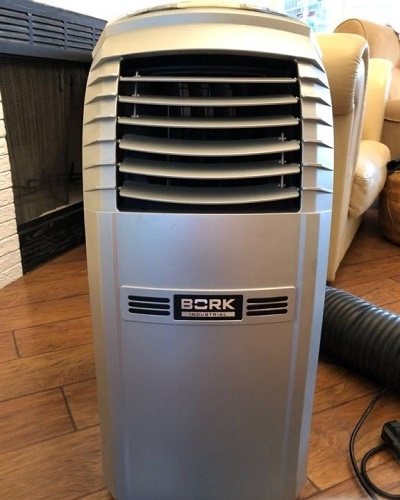

Rooftops
Rooftops are air conditioners for cooling and heating, the units of which are located on the roof, as a rule, on opposite sides of the roof covering at a minimum distance. Such an installation helps to distribute heat as evenly as possible over the entire area of the house. In addition, rooftops do not need additional air supply to cool the surface of the outdoor unit.
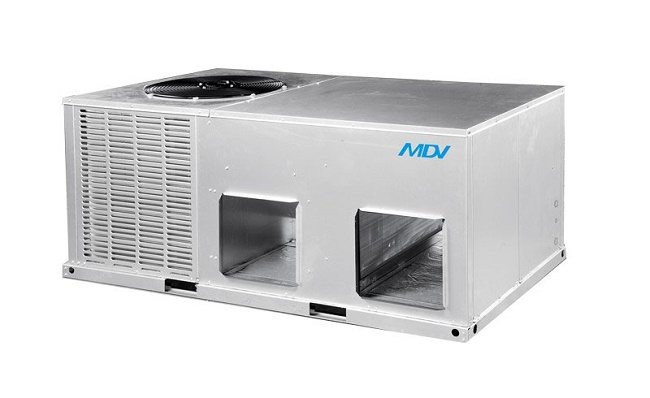

The advantages of the heating method
- Efficiency... This is the most significant advantage of the device. When compared with other methods of space heating, the use of an air conditioner is most effective. The efficiency is 3-4 times higher than that of the underfloor heating system, convectors and other devices based on a heating element.
- Speed... Most heating systems function only in a certain microclimate. Heating is slow. You have to wait until the temperature reaches the required value. The air conditioner works on the basis of forced ventilation. The air is not heated by the heating element. A warm draft penetrates the atmosphere of the room. Heating is much faster.
- Control... Modern models have several modes. The owner can control the heating of the air. The required temperature is set. In the process, you can change the parameters. For this, you do not need to perform many actions. The instructions describe in detail the rules of operation. If you follow all the recommendations, the use of the air conditioner will be convenient and quick. It is impossible to control underfloor heating. Such a system will require a lot of money.
- Service... The maintenance of the air conditioner does not require careful maintenance. It is enough to periodically flush the indoor unit. External elements are cleaned as dust and dirt accumulates. Other heating systems only work with regular maintenance. It is necessary to monitor the condition of the heating element, as it wears out over time. You have to carefully look after the installation of underfloor heating, otherwise, a breakdown will occur, the elimination of which will take a lot of time, effort and finances.
- Installation... A minimum of effort and space is required to install the air conditioner. It is enough to free a part of the wall so that the equipment does not interfere with the furniture. The device, when turned off, does not interfere with the homework of the residents. Installation of underfloor heating should preferably be carried out at the stage of home improvement.During your stay, it is very difficult to do this. Installation will take a lot of time and effort. Also, warm floors are expensive. It is enough to put convectors indoors. However, when not needed, it is removed until next winter. The device takes up a lot of space, you need to find a room where it will stand.
- Versatility... Most heating systems only function in winter when warm air is needed. The air conditioner is a universal device. In summer, it performs a standard function - it cools the atmosphere.
- Heating independence... The air conditioner is powered by electricity. The device does not need to be connected to a heating system, unlike other heating devices. This allows the owner to independently control the degree of heating and the maximum temperature.
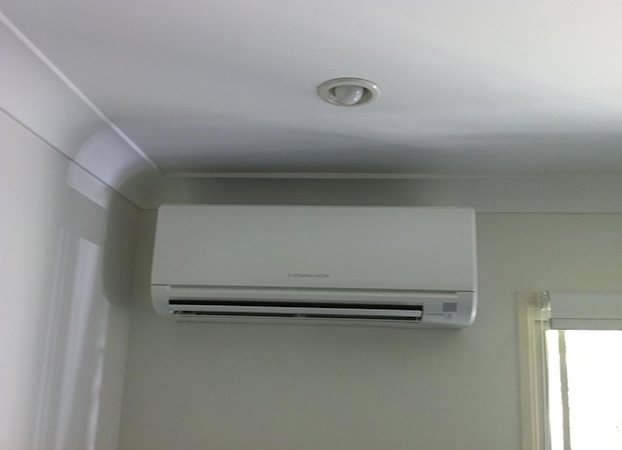

Criteria for choosing heated air conditioners
Modern air conditioners are multifunctional devices. To choose the best option, you should consider the following criteria:
- the minimum allowable outdoor air temperature for work;
- maximum thermal power;
- energy efficiency COP;
- noise level;
- performance, which must correspond to the heated area;
- installation cost;
- the presence of filters to clean the air from dust particles, allergens, bacteria, as well as from unpleasant odors;
- the presence of a built-in on and off timer, which allows you to warm up the air in the apartment at a certain moment;
- the presence of an auto-defrosting system designed to minimize the risk of icing of the external module;
- the presence of a restart function, which will help to automatically restore work in the event of a power outage;
- availability of a "winter kit", which will be required when operating equipment in cold weather;
- proven manufacturer.
The advantages and disadvantages of such heating
Air conditioners and split systems, providing for the possibility of heating a room, have their own advantages and disadvantages. After careful analysis of real user reviews, the main aspects were highlighted in the following table.
| pros | Minuses |
| High efficiency. | High price of split systems with heating mode. |
| Rapid air heating. | A complex device. |
| Low energy consumption compared to heaters, since electricity is not spent on generating heat, but only on transferring it. | The need to use a winter kit. |
| More even distribution of heat in the room compared to stationary heaters. | To avoid lubrication downtime, the air conditioner must be switched on periodically. |
| Since air conditioners do not have a heating element (such as heating elements), they practically do not burn air in the room and do not emit carbon monoxide. | When installing equipment operating on the principle of heat pumps, careful and complex design is necessary, otherwise separate cold zones may appear in the room, and condensation will settle on the glass. |
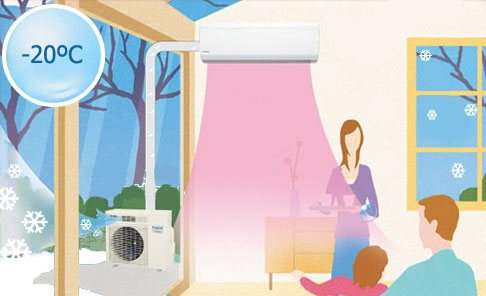

Recommendations for use
To extend the life of the air conditioner and achieve high productivity of its operation, the following rules must be observed:
- change filters periodically;
- regularly top up the refrigerant, as its volume decreases over time - on average, this should be done every 3 years;
- comply with the recommended temperature regime of the device as accurately as possible;
- in winter, cover the outdoor unit with a waterproof material.
So, in order to find out the whole truth about the advantages of using an air conditioner that runs on heating, it will be useful to look for information about various models, study the reviews and personal experience of the owners in specialized forums. The forumhouse, which is dedicated to country life and construction, has many articles on this topic, as well as cost calculations and user advice.

